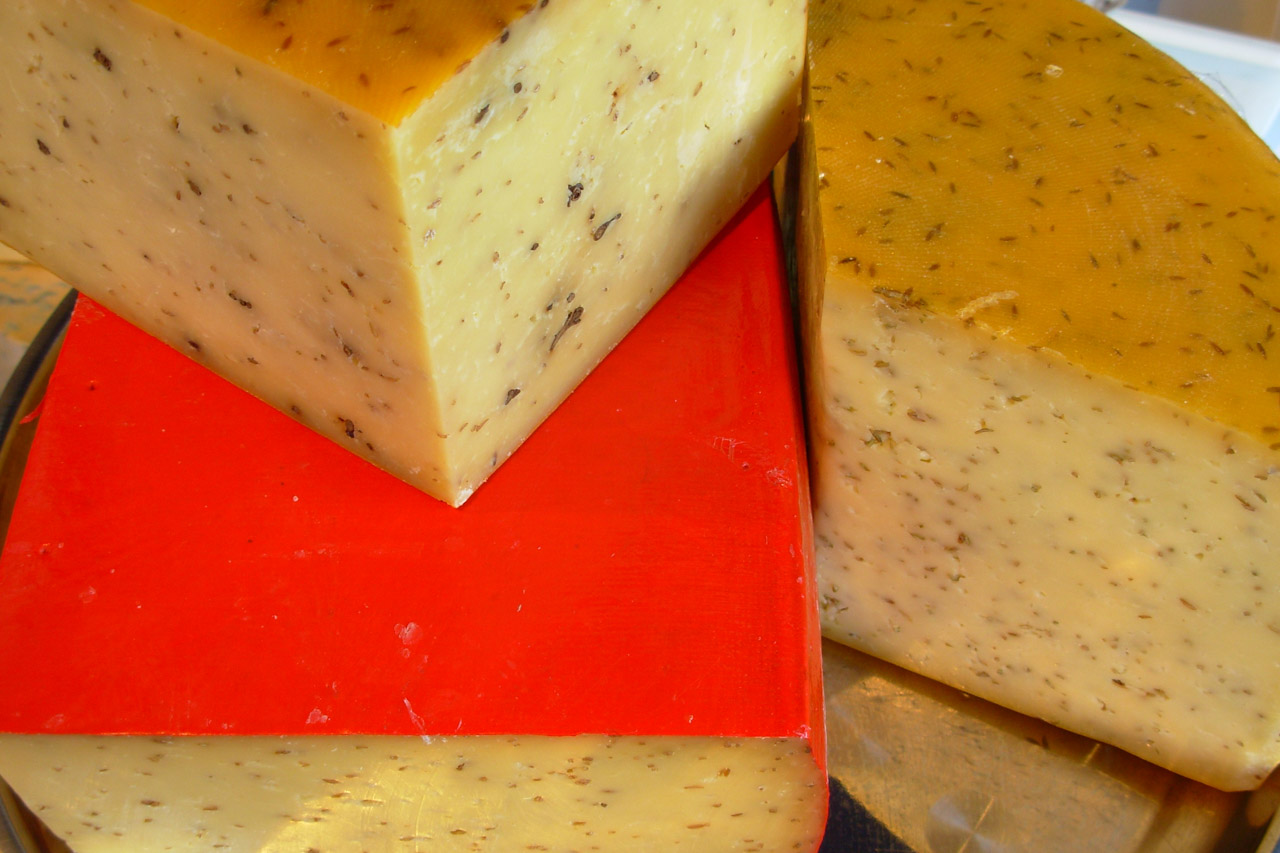Description
The Kanterkaas, Kanternagelkaas, andKanterkomijnekaas PDO are hard cheeses produced from pasteurized milk that can also be flavoured with cloves and/or cumin.
Production Area
The Kanterkaas, Kanternagelkaas andKanterkomijnekaas PDO production area lies in the Friesland and Groningen regions.
Production Method
Milk used for the production is delivered to the dairy at a temperature of 4°C, then subjected to a heat treatment for several hours, and pasteurized at a temperature of 72°C for about 15 seconds. Calf or beef rennet is then added at 30°C and a mixture of typical acidifying bacteria in order for the Kanterkaas PDO to reach the desired acidity. The fresh cheese obtained is then washed until the desired pH is achieved. Cumin is added to obtain the Kanterkomijnekaas PDO, and also to the Kanternagelkaas PDO but in smaller quantities. The cheese is then left to ripen and reach the desired pH. The curd of the Kanterkaas PDO and Kanterkomijnekaas PDO processing is ground, salted and put into a tank, after which it is then placed in the moulds, pressed and left to ripen. To achieve the Kanternagelkaas PDO the curd is spun and cloves and salt are added, and is then finally moulded, pressed and ripened. The minimum ripening time is at least four weeks at 12°C.
Appearance and Flavour
Kanterkaas, Kanterkomijnekaas and Kanternagelkaas PDO have a flattened cylindrical shape. The rind of the Kanterkaas, Kanterkomijnekaas and Kanternagelkaas PDO are normally natural or treated with a colourless or yellowish liquid coating for cheeses, a reddish liquid coating can also be used for the Kanterkomijnekaas PDO. The Kanterkaas PDO has a pleasant flavour that ranges from spicy to strong depending on the degree of ripening. The Kanternagelkaas PDO with cloves has a fragrant, spicy and pleasant flavour ranging from spicy to strong depending on age. The Kanterkomijnekaas PDO with cumin has a scented, spicy and pleasant flavour and varies from mild to strong depending on the age. These firm cut cheeses have a uniform ivory, yellow or greenish-yellow colour. The rind is smooth, compact and without mould. The consistency varies from firm to hard. The weight of each form is between 3 and 8.5 kg.
History
The history of Kanterkaas, Kanternagelkaas and Kanterkomijnekaas PDO is closely linked to the ancient tradition of the Dutch cheese production. The cheeses were initially sold in local markets only, and later began to be exported becoming known in many European countries, as is proven by the customs ledgers dating back to 1532. The Kanternagelkaas was very popular in the second half of the 19th century due to the addition of cumin and cloves. Industrial production began in 1890 using a procedure very close to the traditional one.
Gastronomy
The Kanterkaas, Kanternagelkaas and Kanterkomijnekaas PDO could be kept in the refrigerator adequately coated. Thanks to its solid to hard texture, this cheese can be eaten sliced or grated. Excellent as a snack or dish, and is widely used in food preparations and as an ingredient in salads.
Marketing
The product is sold as Kanterkaas PDO, Kanternagelkaas PDO and Kanterkomijnekaas PDO. The Kanterkaas PDO is available for consumption in two variations depending on the fat content: Kanterkaas PDO 20+ with fat content between 20% and 25%; Kanterkaas PDO 40+ with fat content between 40% and 44%. It is marketed in vacuum packs of various weights.
Distinctive Features
The excellent quality of the Kanterkaas, Kanternagelkaas and Kanterkomijnekaas PDO cheese is due to the environmental and soil-climatic conditions of the production area. In fact the area is characterized by an unpolluted environment, especially suited to the breading of dairy animal, which produces excellent quality forage and the livestock have a very broad grazed areas, factors that lead to a high quality milk.






